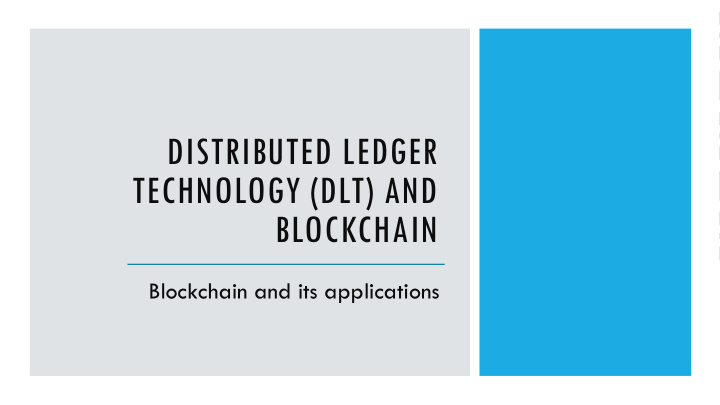



DISTRIBUTED LEDGER TECHNOLOGY (DLT) AND BLOCKCHAIN Blockchain and its applications
INTRODUCTION Ishmeet Singh, Blockchain Consultant I have built technology products for Fortune 500 companies like MasterCard, MetLife and Adobe. I have also built and scaled data-driven, intelligent technology platforms for hedge funds, finance, e- commerce, travel and healthcare companies. I consult for and advise multi-million-dollar companies and startups on the application of artificial intelligence, machine learning, big data and Blockchain to solve real world problems.
Fundamental Concepts What is DLT? What is Blockchain Technology? SESSION DETAILS Types of Blockchains How does Blockchain work? Examples
LEDGER A collection of transactions or data
TRANSACTION An asset transfer onto or off the ledger
CONTRACT Conditions for transaction to occur
NODES Network participants in a distributed ledger network
PEER-TO-PEER (P2P) NETWORK A decentralized/distributed network of nodes that stores, updates, and maintains a distributed ledger
CENTRALIZED LEDGER
DISTRIBUTED LEDGER A consensus of replicated, shared, and synchronized digital data geographically spread across multiple nodes
PUBLIC KEY CRYPTOGRAPHY An asymmetric encryption scheme that uses two sets of keys: a public key that is widely disseminated and a private key that is only known to the owner
PUBLIC KEY CRYPTOGRAPHY FOR DIGITAL SIGNATURES
CONSENSUS ALGORITHM A consensus algorithm is a process in computer science used to achieve agreement on a single data value among distributed processes or systems.
SMART CONTRACT A permanent and immutable collection of code that runs on the blockchain
Distributed Ledger Technology Blockchain DLT AND BLOCKCHAIN Directed Acyclic Graphs
WHAT IS DISTRIBUTED A technology that allows for transactions and data to be recorded, shared, and LEDGER TECHNOLOGY synchronized across a distributed network of nodes using cryptographic (DLT)? tools and a distributed consensus process in an immutable manner
PROBLEM STATEMENT Business networks are inefficient, expensive and vulnerable
A decentralized, distributed and public/private digital ledger A type of data structure that stores and transmits data in packages called ‘blocks’ that are WHAT IS A connected to each other in a digital ‘chain’ BLOCKCHAIN? Blockchains employ cryptographic and algorithmic methods to record and synchronize data across the network in an immutable manner Data records are added to the blockchain when multiple distributed parties come to consensus based on pre-agreed rules
Public TYPES OF BLOCKCHAINS Private, Permissioned
PUBLIC BLOCKCHAIN A public blockchain network is completely open and anyone can join and participate in the network. The network typically has an incentivizing mechanism to encourage more participants to join the network Eg. Bitcoin, Ethereum
PRIVATE, PERMISSIONED BLOCKCHAIN A private blockchain network requires an invitation and must be validated by either the network starter or by a set of rules put in place by the network starter. A permissioned network places restrictions on who is allowed to participate in the network, and only in certain transactions. Eg. Hyperledger
HOW DOES BLOCKCHAIN WORK?
Gains in speed Reduces Risk Cost reductions and efficiency Easier Automation and Increases Trust auditability programmability WHAT ARE THE KEY BENEFITS OF BLOCKCHAIN TECHNOLOGY TO BUSINESSES?
BLOCKCHAIN APPLICATIONS
EXAMPLE 1: BITCOIN & CRYPTOCURRENCIES
EXAMPLE 2: AUDIT AND COMPLIANCE
EXAMPLE 3: SUPPLY CHAIN
THANK YOU! Contact Details E: er.ishmeetsingh@gmail.com M: +91 958 221 8730
Recommend
More recommend